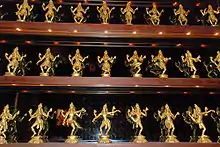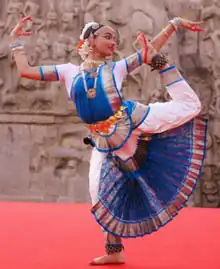
Karanas are the 108 key transitions[1] in the classical Indian dance described in 4th Chapter named "Tandava Lakshana" of Natya Shastra. Karana is a Sanskrit verbal noun, meaning "doing".
Description
Natya Shastra states that Karanas are the framework for the "margi" (pan-Indian classical) productions which are supposed to spiritually enlighten the spectators, as opposed to the "desi" (regional folk or pop dance) productions which can only entertain the spectators. "One who performs well this Karana dance created by Maheswara will go free from all sins to the abode of this deity," states Natya Shastra[2]

Some of the well-known interpretations of karanas are by Padma Subramanyam that were based on 108 brief movement phrases describing specific leg, hip, body, and arm movements accompanied by hasta mudras described in the Natya shastra and other scriptures, and from depictions of the movements in sculpture in five South Indian temples, notably the Chidambaram temple which contains depictions of the full set. Padma Subrahmanyam has written a book called Karanas-Common dance codes of India and Indonesia, based on her research of karanas from the temples of Prambanan(Indonesia), Thanjavur, Kumbakonam, Chidambaram, Thiruvannamalai, and Vriddhachalam. In the 20th century, she was the first dancer to reconstruct the Karanas as movements, which were considered mere poses earlier.
Some other Bharatanatyam gurus, such as Adyar Lakshman (Kalakshetra school), as well as the Kuchipudi gurus Vempati Chinna Satyam and C.R.Acharya have also attempted to reconstruct all the 108 karanas, which were often significantly different from Padma Subrahmanyam's interpretations so much so that even on the chari (leg movement) level there was no agreement as to whose interpretation is correct. Due to the significant variations in the depictions, most traditional Bharatanatyam schools considered Padma Subrahmanyam's style, which incorporated Karanas as incorrect, which forced her to name her own style as Bharatanrityam rather than Bharatanatyam. Many of Padma Subrahmanyam's disciples, such as Bala Devi Chandrashekar (SPNAPA Academy of performing arts) - Sujatha Mohan (Padmashree Nrithyalaya), Uma Sriram, Jayashree Rajagopalan, Dominique Delorme (France) and others are teaching the 108 karanas based on Subramanyam's research.
There used to be devadasis who performed all the 108 karanas. Still, now in most contemporary Bharatanatyam or Odissi schools, only a small number of karanas and their derivatives have been transmitted by parampara up to date.
Apart from that, performing of the same Karana differs greatly across different classical Indian styles. Currently, as regards the exact technique, there are no established standards and no universally agreed-upon interpretations of the texts and sculptures.
List of 108 Karanas
- Talapuṣpapuṭam
- Vartitam
- Valitōrukam
- Apaviddam
- Samanakam
- Līnam
- Swastikarēchitam
- Manḍalaswastikam
- Nikuṭṭakam
- Ardhanikuṭṭam
- Kaṭīchinnam
- Ardharēchitam
- Vakśaswastikam
- Unmattam
- Swastikam
- Pṛṣṭhaswastikam
- Dikswastikam
- Alātam
- Kaṭīsamam
- Ākśiptarēchitam
- Vikśiptākśiptam
- Ardhaswastikam
- Añchitam
- Bhujaṅgatrāsitam
- Ūrdhvajānu
- Nikuñchitam
- Mattalli
- Ardhamattalli
- Rēchitanikuṭṭam
- Pādāpaviddakam
- Valitam
- Gūrṇitam
- Lalitam
- Daṇḍapakśam
- Bhujaṅgatrastarēchitam
- Nūpuram
- Vaiṣākharēchitam
- Bhramaram
- Chaturam
- Bhujaṅgāñchitam
- Daṇḍarēchitam
- Vṛśchikakuṭṭitam
- Kaṭībhrāntam
- Latāvṛśchikam
- Chinnam
- Vṛśchikarēchitam
- Vṛśchikam
- Vyamsitam
- Pārśvanikuṭṭakam
- Lalāṭatilakam
- Krāntam
- Kuñchitam
- Chakramaṇḍalam
- Urōmaṇḍalam
- Ākśiptam
- Talavilāsitam
- Argaḷam
- Vikṣiptam
- Āvartam
- Dōlāpādam
- Vivṛttam
- Vinivṛttam
- Pārśvakrāntam
- Niṣumbhitam
- Vidyutbhrāntam
- Atikrāntam
- Vivartitakam
- Gajakrīḍitam
- Talasamsphoṭitam
- Garuḍaplutam
- Gaṇḍasūchī
- Parīvṛttam
- Pārśvajānu
- Gṛdrāvalīnakam
- Sannatam
- Sūchī
- Ardhasūchī
- Sūchīviddham
- Apakrāntam
- Mayūralalitam
- Sarpitam
- Danḍapādam
- Harinaplutam
- Prēnkōlitam
- Nitambam
- Skalitam
- Karihastam
- Prasarpitam
- Simhavikrīḍitam
- Simhākarṣitam
- Udvṛttam
- Upaśṛtam
- Talasaṅghaṭṭitam
- Janitam
- Avahittakam
- Nivēśam
- Ēlakākrīditam
- Ūrūdvṛttam
- Madaskalitam
- Viṣṇukrāntam
- Sambhrāntam
- Viśkhambam
- Udghaṭṭitam
- Vṛśabhakrīḍitam
- Lōlitam
- Nāgāpasarpitam
- Śakaṭāsyam
- Gaṅgāvataranam
See also
References
- ↑ ""108 Karanas: The Karanas are synchronized movement of hands and feet"". Site.voila.fr. Archived from the original on 2012-07-22. Retrieved 2012-05-09.
- ↑ Natya Shastra translated by Manmohan Ghosh 2002 Chowkhamba Press, Varanasi ISBN 81-7080-079-X - Page 75.
External links
- Padma Subrahmanyam, "Bharatha Natyam - Classical Dance of the Ancient Tamils. The Role of Dance Sculptures in Tamilnad (1968) P. Subrahmanyam's introduction, with pictures illustrating 108 karanas.